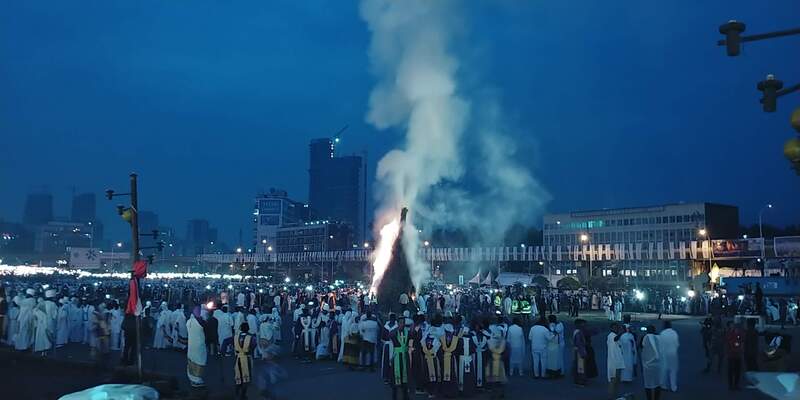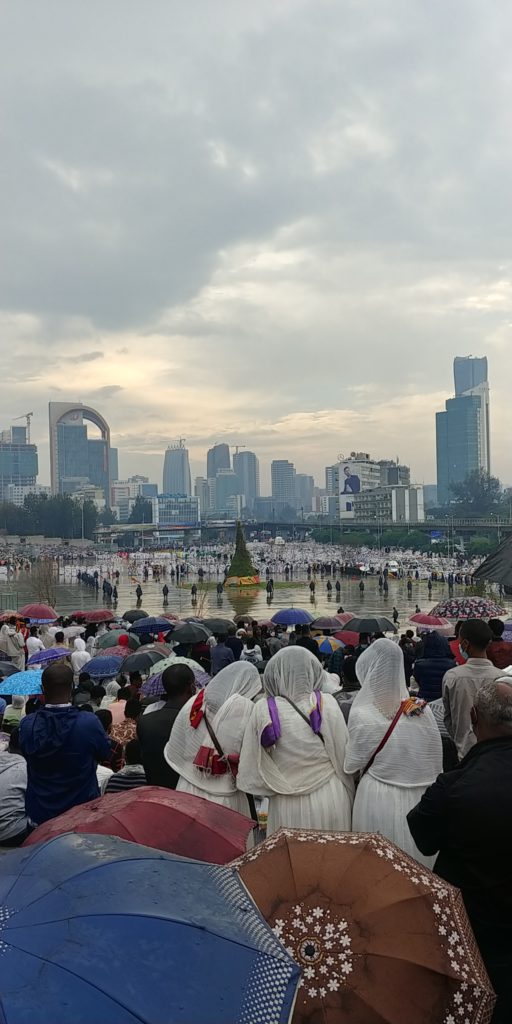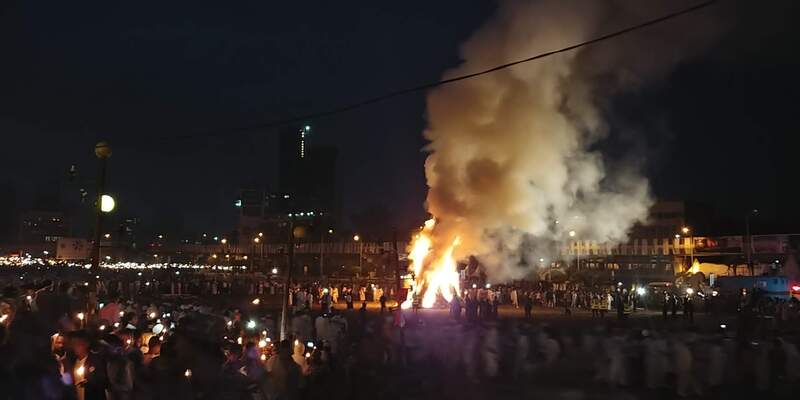WHAT IS MESKEL (Maskal) ? Meskel is an annual festival commemorating the finding of the true cross of Jesus Christ, observed primarily on September 27 or 28 of Leap Year as a religious and cultural celebration among Millions of people in Ethiopia.
Meskal also Means many things: It is a festival of Bone fire and flowers as the land of Ethiopia is decorated with a yellow flower at the Ethiopian New Year, but it is not only fire or flowers. It is a culture where people gather for a day of celebration and song, but it is not only a celebration or song. It is a day of solemn religious services and joyous secular celebrations. But it is all about the finding of the True Cross.

How Meskel is Celebrated
Though the story of Maskal Celebration reaches back into the pages of antiquity, its meaning is renewed each year. Maskal falls at the end of the long rainy season. It is marked by riotous flowering throughout the nation.
There are many well-known symbols of Maskal celebrations that are woven intimately into the lives of all Ethiopians. These symbols mark the day itself:
Demera Or Bone Fire
Demera, it is a massive pole set up on the eve of Maskal in every city, town, and village at the Eve of Mekel; Men and boys in the village gather and place long poles until an enormous pyramid is built. Later they Put Grasses and Maskal daisies or yellow flowers to make decorations. In the night elders come together and make a blessing. In a church, priests pray and chant around the pile with Cross and burn incense; Make a procession three times around the Demera. While twigs and branches are thrown into its base By the people; at dusk, they set fire to the poles or Demera; through the night they carry chibos( lighted torches), to the bonfire where they are hurled into the blaze; they will sing and chant and circling of the blaze, and, finally, the next day, on Maskal itself, the gathering of the charcoal of the burned wood which men and women take home to break into dust and used to anoint their foreheads with the Sign of the Cross.
Meskel Celbration at Homes and Villages
Every village or hamlet will have its own Maskal fire that night, and from any high place, one may see many flickering points of light scattered far and near across the darkened landscape. The young men of the village rush out from their homes with lighted torches the chibos – which they hurl into the blaze. And when all are assembled, they move round and round the blazing fire in a circle, chanting the traditional Maskal songs.
The following morning, on Maskal Day, men and women take up the charcoal of the burnt wood, bear it home, and, breaking it up, rub it on their palms and, with a finger of the right hand, anointing their foreheads with the sign of the Cross. For this is the Feast of the Cross and the charcoal is its mark.

THE CEREMONY of Meskel in Public
Though the celebration of Mekel is still the same, below we put how Maskel was celebrated during the old times In Addis Ababa.
On the twenty-seventh (28 on leap year) of September each year just at the end of the rainy season when flowers appear on the hill and plain in wonderful profusion, and the whole landscape goes yellow with “Maskal” daisies – the Ethiopian nation observes Maskal or the Festival of the Finding of the True Cross upon which was crucified our Lord and Savior Jesus Christ.
The Festival of the Cross is a great time for rejoicing. Like all other major church holidays, Maskal commands an enormous appeal in all parts of the country. It is observed with the appropriate church services, a national holiday, and, in Addis Ababa, an Imperial Luncheon.
Maskal is proper is preceded by the highly colorful annual ceremony of Demera( Pile of Wood), observed a day earlier on the eve of the Finding of the True Cross. That day in every community a massive pole or demera is set up in some open space. Later in the afternoon, everybody assembles around such poles with men and boys bringing along their own long, thin poles, their ends decorated with Maskal daisies, and setting them up against the big one already erected until these grow to become sizeable and sometimes enormous pyramids.
As multitudes of people watch in readiness to participate in the bonfire to follow, a half-religious and half-secular ceremony is held. Following this, the priests and deacons (in Addis Ababa it is His Holiness the Patriarch assisted by members of the clergy) officiate at the ceremony, circle around the Demera with the Cross and incense, and bless the pile. After them revolve the dignitaries — in Addis Ababa, the Emperor and members of the Royal Family — followed by the assembled masses of people: all of them making a procession around the pyramid of poles, encircling it three times according to tradition, throwing twigs and tree branches at its base, and singing Ioha Ababaie-Meskerem Tebaie (The Light of the Cross is Revealed, The New Year has dawned).
And then at dusk, the huge Maskal pole with the surrounding reeds is set on fire, making a splendid blaze symbolizing the search for, and the success in finding, the original Cross on which Jesus Christ was crucified.
The Story of the True Cross in Ethiopia
The festive of Meskel is a familiar symbol, known and shared by millions of Ethiopians and known, too, by many from other countries who have been moved by the profound Christianity and colorful symbolism of the feast. But there is another symbol of the day, less known in all the details of its history even to many Ethiopians. It is the fragment of the true Cross of Jesus Christ that lies high and remote in inaccessible mountains, far removed from the festivities, brooding over all other symbols of the day.
The fragment of the True Cross lies Lies in a Holly Sanctuary, High on a cross-shaped plateau, in a cross-shaped church at the monastery of Gishen Mariam.
Monophysite Christianity, which holds that the divine and human nature of Christ are united in one form, has been Ethiopia’s official religion since the fourth century after the birth of the Christian era. As the most profound expression of the national existence of its people, the church observes a prodigious number of church feasts and festivals. Maskal or the Festival of the Finding of the True Cross is observed throughout the nation each year.

Just at the end of the rainy season. The event commemorates the success of the pious queen Helena, mother of the emperor Constantine I of Rome, in finding the holly cross on which Christ was crucified. It is said in 326 Ad. through divine guidance, the true Cross was unearthed from the spot where the Jews had buried it at Golgotha.
Maskal has been observed in Ethiopia as a religious and secular festival ever since. However, the event received even greater Christian sanction and significance at the end of the fourteenth century — when by a miraculous chain of events a fragment of the original Cross was brought to Ethiopia, occasioning much rejoicing throughout this ancient Christian realm.
The following pages will attempt to describe – with as much coherence as closely interwoven Christian history, folklore, and legends will allow — the events leading to that historic episode, the personalities of the main characters involved, as well as the legends surrounding the monastery of Gishen, long-time Ethiopian home of the said fragment of the Holy Cross.
The LEGEND ABOUT THE TRUE CROS (MESKEL)
According to legend, Queen Helena (Eleni in Ethiopian scriptures), in her efforts to discover the Holy Cross, set up long poles and set them afire, and burned incense. Skyward rose the smoke and down it bent, touching the spot on the earth where the original Cross was found buried. After the unearthing of the Holy Cross, Queen Helena lit up torches heralding her success in the neighboring areas.
According to “The Ethiopian Synaxarium”( መጽሐፈ፡ ስንክሳር), the spot where the Cross Was unearthed was Golgotha, and the year was 326 after the birth of Christ and in the twentieth year of the reign of Queen Helena’s son, Emperor Constantine I, the first Christian King of Rome. The “Synaxarium,” the book of the saints of the Ethiopian Church and a vast storehouse of Christian traditions, legends, and folklore, has this to say about this important event:
“And the blessed woman Helena took a large sum of his money, and she said unto her Constantine, I wish to be blessed by God, and I will go the holy city of Jerusalem, and I will seek for and discover the wood of the life-giving Cross”. And Constantine rejoiced at these words, and he sent soldiers with her, and he gave her much money and apparel made of costly silks threaded with gold. When she arrived in the City of Jerusalem and had kneeled in prayer in certain of the holy places, she made inquiries about the Wood of the Honorable and life-giving Cross. And with much toil and tribulation, she found the Wood of the Cross, and she praised it with great praises, and she paid unto it very great reverence and honor. Then she commanded her men to build the altar of the sanctuary and (shrines at) Golgotha, and Bethlehem, and the cave wherein our Lord Jesus Christ was born, and the fortress of Lion, and the Gethsemane wherein was buried the body of our Lady the Holy Virgin Mary, and the Mount of Olives, and all the holy places; and she commanded (of the soldiers) to decorate them with pearl, and with gold, and with silver.”
At this point, “The Ethiopic Synaxarium” goes on, a certain bishop and holy man named Aba Macarius, from Jerusalem, counseled Queen Helena, saying:
“Do not thus, for after a few days (foreign) peoples will come and will rule over this country, and they will take possession of this place and will lay it waste, and will seize whatsoever is made of gold and silver and precious stones. But it is meet that you should build a good, strong building which can neither be overthrown nor torn up from the foundations. And the remainder of this money gives unto the poor and the needy.”’
The building was constructed according to bishop Macarius’ advice, Queen Helena’s son, Emperor Constantine, then sent messages to the Archbishops of Constantinople, Alexandria, and Antioch and commanded them to Jerusalem to consecrate the sanctuary and all the altars of the places which had been built by his mother.
“And they all assembled in the City of Jerusalem, and they tarried there until the seventeenth of the day of Maskaram (September 27) by which day they had consecrated the sanctuary and all the altars of the places (shrines) which had been built. On that day there was joy, the like of which had never before existed. a great light appeared, and many signs were wrought on that day, the sixteenth of Maskaram (the eve of + Maskal Festival).”
Ever since then, the fourth century after the birth of Christ, Ethiopians like all other Monophysite Christians, have been observing the Festival of the Cross in the firm and honest belief that “Maskal is our strength. Our might, the savior of our soul.”
WHERE IS THEBTRUE CROSS (MESKEL) NOW ?
The Fragment of the True Cross is now found in Ethiopia at a forbidden mountain massifs of Ambasel in Wollo, north Ethiopia, inside of the historical monastery of Gishen Mariam. Kept in the innermost sanctuary of the church of Egziabherab. All this History has been recorded on a Manuscript called “Tefut” written by the order of Emperor Zar’ Yacob (1434-68). It describes the story of the True Cross and its way to Ethiopia in detail.
